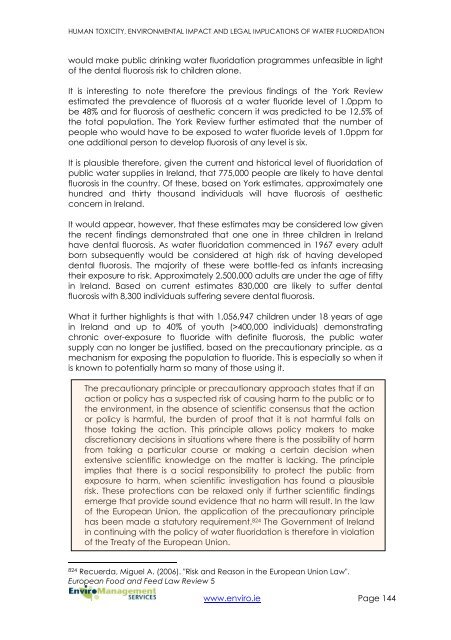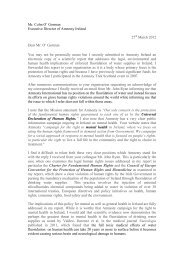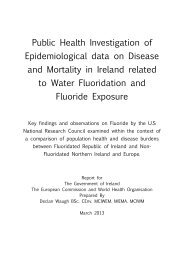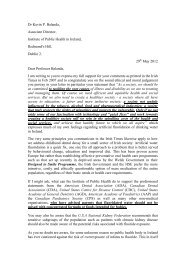Human Toxicity, Environmental Impact and Legal Implications of
Human Toxicity, Environmental Impact and Legal Implications of
Human Toxicity, Environmental Impact and Legal Implications of
Create successful ePaper yourself
Turn your PDF publications into a flip-book with our unique Google optimized e-Paper software.
HUMAN TOXICITY, ENVIRONMENTAL IMPACT AND LEGAL IMPLICATIONS OF WATER FLUORIDATION<br />
would make public drinking water fluoridation programmes unfeasible in light<br />
<strong>of</strong> the dental fluorosis risk to children alone.<br />
It is interesting to note therefore the previous findings <strong>of</strong> the York Review<br />
estimated the prevalence <strong>of</strong> fluorosis at a water fluoride level <strong>of</strong> 1.0ppm to<br />
be 48% <strong>and</strong> for fluorosis <strong>of</strong> aesthetic concern it was predicted to be 12.5% <strong>of</strong><br />
the total population. The York Review further estimated that the number <strong>of</strong><br />
people who would have to be exposed to water fluoride levels <strong>of</strong> 1.0ppm for<br />
one additional person to develop fluorosis <strong>of</strong> any level is six.<br />
It is plausible therefore, given the current <strong>and</strong> historical level <strong>of</strong> fluoridation <strong>of</strong><br />
public water supplies in Irel<strong>and</strong>, that 775,000 people are likely to have dental<br />
fluorosis in the country. Of these, based on York estimates, approximately one<br />
hundred <strong>and</strong> thirty thous<strong>and</strong> individuals will have fluorosis <strong>of</strong> aesthetic<br />
concern in Irel<strong>and</strong>.<br />
It would appear, however, that these estimates may be considered low given<br />
the recent findings demonstrated that one one in three children in Irel<strong>and</strong><br />
have dental fluorosis. As water fluoridation commenced in 1967 every adult<br />
born subsequently would be considered at high risk <strong>of</strong> having developed<br />
dental fluorosis. The majority <strong>of</strong> these were bottle-fed as infants increasing<br />
their exposure to risk. Approximately 2,500,000 adults are under the age <strong>of</strong> fifty<br />
in Irel<strong>and</strong>. Based on current estimates 830,000 are likely to suffer dental<br />
fluorosis with 8,300 individuals suffering severe dental fluorosis.<br />
What it further highlights is that with 1,056,947 children under 18 years <strong>of</strong> age<br />
in Irel<strong>and</strong> <strong>and</strong> up to 40% <strong>of</strong> youth (>400,000 individuals) demonstrating<br />
chronic over-exposure to fluoride with definite fluorosis, the public water<br />
supply can no longer be justified, based on the precautionary principle, as a<br />
mechanism for exposing the population to fluoride. This is especially so when it<br />
is known to potentially harm so many <strong>of</strong> those using it.<br />
The precautionary principle or precautionary approach states that if an<br />
action or policy has a suspected risk <strong>of</strong> causing harm to the public or to<br />
the environment, in the absence <strong>of</strong> scientific consensus that the action<br />
or policy is harmful, the burden <strong>of</strong> pro<strong>of</strong> that it is not harmful falls on<br />
those taking the action. This principle allows policy makers to make<br />
discretionary decisions in situations where there is the possibility <strong>of</strong> harm<br />
from taking a particular course or making a certain decision when<br />
extensive scientific knowledge on the matter is lacking. The principle<br />
implies that there is a social responsibility to protect the public from<br />
exposure to harm, when scientific investigation has found a plausible<br />
risk. These protections can be relaxed only if further scientific findings<br />
emerge that provide sound evidence that no harm will result. In the law<br />
<strong>of</strong> the European Union, the application <strong>of</strong> the precautionary principle<br />
has been made a statutory requirement. 824 The Government <strong>of</strong> Irel<strong>and</strong><br />
in continuing with the policy <strong>of</strong> water fluoridation is therefore in violation<br />
<strong>of</strong> the Treaty <strong>of</strong> the European Union.<br />
824 Recuerda, Miguel A. (2006). "Risk <strong>and</strong> Reason in the European Union Law".<br />
European Food <strong>and</strong> Feed Law Review 5<br />
www.enviro.ie Page 144






